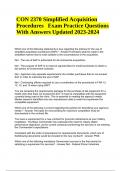College aantekeningen
Lectures Infectious Diseases and Vaccine Development (AB_1046) (minor Biomedical and Health Interventions)
- Vak
- Instelling
Notes of all the lectures given during the course Infectious Diseases and Vaccine Development (minor Biomedical and Health Interventions). The document also contains many useful images that match the explanation of the course material. (vak voor o.a. gezondheidswetenschappen, gezondheid en leven, ...
[Meer zien]













